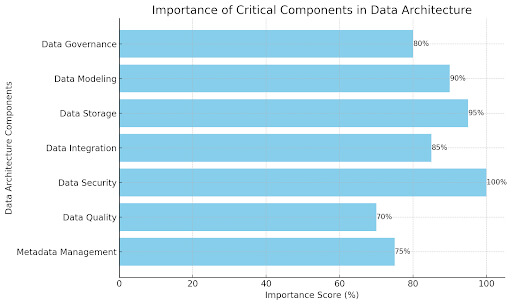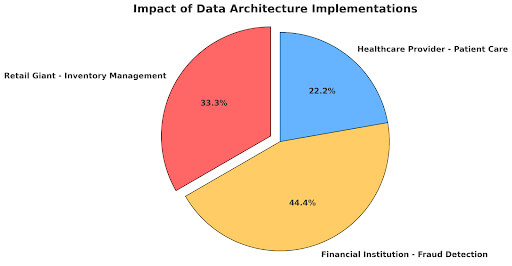Designing and Implementing a Data Architecture

Organizations are bombarded with information from various sources in today’s data-driven world. Data is an invaluable asset, but it can quickly become a burden without proper organization and management.
What is data architecture?
Data architecture is the blueprint for how your organization manages its data. It defines the structure, organization, storage, access, and data flow throughout its lifecycle. Think of it as the foundation upon which your data ecosystem is built.
Why is Data Architecture Important?
A well-defined data architecture offers a multitude of benefits for organizations. Here’s a glimpse of the impact it can have:
- Improved Decision-Making: By ensuring data accuracy and consistency across the organization, data architecture empowers businesses to make data-driven decisions with confidence. A study by Experian revealed that companies with a well-defined data governance strategy are 2.6 times more likely to be very satisfied with their overall data quality.
- Enhanced Efficiency: A structured data architecture eliminates data silos and streamlines data access. This results in increased operational effectiveness and decreased time spent searching for or integrating data from disparate sources.
- Boosted Compliance: Big data architecture is crucial in data governance and compliance. By establishing clear data ownership and access controls, businesses can ensure they adhere to legal regulations and mitigate data security risks.
- Scalability for Growth: A well-designed data architecture is built with flexibility in mind. As a result, businesses can expand their data infrastructure seamlessly and accommodate future data volume and complexity growth.
The Challenges of Unstructured Data
Without a data architecture, organizations face a multitude of challenges:
- Data Silos: Data gets fragmented and stored in isolated locations, making it difficult to access and analyze.
- Data Inconsistency: Consistent data definitions and formats lead to errors and poor data quality.
- Security Risks: Uncontrolled data access and lack of proper security measures increase the risk of data breaches.
- Slow Decision-Making: The time and effort required to locate and integrate data significantly slow the decision-making process.

Critical Components of a Data Architecture
A robust data architecture relies on core elements working together seamlessly, like a well-built house requiring a solid foundation and essential components. Here’s a breakdown of these critical components:
- Data Governance is the general structure used to manage data as a strategic asset. It establishes roles, responsibilities, and processes for data ownership, access control, security, and quality. A study by Gartner revealed that 80% of organizations plan to invest in data governance initiatives in the next two years, highlighting its growing importance.
- Data Modeling: This involves defining the structure and organization of data within your data storage systems. Data models ensure consistency and accuracy by establishing clear definitions for data elements, their relationships, and the rules governing their use.
- Data Storage: Choosing the proper data storage solutions is crucial. Common options include:
- Relational databases: Structured data storage ideal for transactional processing and queries (e.g., customer information, product catalogs).
- Data warehouses: Designed for historical data analysis, Data warehouses combine information from multiple sources into one central location for in-depth reporting. According to a study by Invetio, 63% of businesses leverage data warehouses for advanced analytics.
- Data lake architecture provides a scalable and adaptable method for storing substantial amounts of information and semi-structured and unstructured data.
- Relational databases: Structured data storage ideal for transactional processing and queries (e.g., customer information, product catalogs).
- Data Integration: Organizations often have data scattered across different systems. Data integration strategies combine data from various sources (databases, applications, external feeds) to create a unified view for analysis and reporting.
- Data Security: Protecting private information against illegal access, alteration, or loss is paramount. Data security measures include encryption, access controls, and intrusion detection systems.
The IBM Cost of a Data Breach Report 2023 indicates that the global average data breach expense attained a record high of $4.35 million, highlighting the financial impact of data security breaches. - Data Quality: Ensuring data accuracy, completeness, consistency, and timeliness is essential for reliable analysis and decision-making. Data quality management processes involve cleansing, validation, and monitoring to maintain data integrity. Poor data quality costs US businesses an estimated $3.1 trillion annually, according to a study by Experian.
- Metadata Management: Metadata provides vital information about your data – its definition, lineage, usage, and location. Effective metadata management facilitates data discovery, understanding, and governance.

The Data Architecture Design Process
Building a data architecture isn’t a one-size-fits-all approach. The design process should be tailored to your organization’s needs and goals. Here’s a roadmap to guide you through the essential steps:
- Define Business Goals and Data Requirements: Understanding your business objectives is the foundation of a successful data architecture. It is crucial to identify KPIs (key performance indicators) and the information needed to monitor them.
For example, an e-commerce platform might focus on KPIs like customer acquisition cost and conversion rate, requiring data on marketing campaigns, customer demographics, and purchasing behavior. - Analyze Existing Data Landscape: Before building new structures, it’s essential to understand your current data environment. This involves taking stock of existing data sources (databases, applications, spreadsheets), data formats, and data quality issues.
A study by Informatica found that only 12% of businesses believe their data is entirely accurate and usable, highlighting the importance of assessing your current data landscape. - Select Appropriate Data Management Tools and Technologies: You can select the right tools and technologies by clearly understanding your data needs. This includes choosing data storage solutions (relational databases, data warehouses, data lakes), data integration tools, and data governance platforms.
- Develop an Implementation Plan with Clear Phases and Milestones: A well-defined implementation plan breaks down the data architecture project into manageable phases. Each phase should have clear goals, milestones, and resource allocation. This keeps the project on course and delivers value incrementally.
Additional Considerations:
- Scalability: Design your data architecture with future growth in mind. Choose technologies and approaches that can accommodate increasing data volumes and user demands.
- Security: Data security should be a top priority throughout the design process. Strong security measures should be put in place to safeguard private data.
- Data Governance: Clearly define the rules and processes to ensure compliance with data ownership, access control, and regulation.

Building and Maintaining Your Data Architecture
Having a well-defined data architecture design is just the first step. Now comes the crucial task of implementing and maintaining your data infrastructure. Here’s a breakdown of critical practices to ensure a smooth transition and ongoing success:
Implementing Your Data Architecture:
- Data Migration and Transformation: Moving data from existing systems to your new architecture requires careful planning and execution. Best practices include:
- Data cleansing: Identify and address data quality issues before migration to ensure data integrity in the new system.
- Data transformation: Transform data into the format and structure your target data storage solutions require. According to a study by CrowdFlower, 80% of data science projects experience delays due to data quality and integration issues.
- Data cleansing: Identify and address data quality issues before migration to ensure data integrity in the new system.
- Setting Up Data Pipelines: Data pipeline architecture automates the movement and integration of data between various sources and destinations. This ensures data is continuously flowing through your data architecture, enabling real-time insights and analytics.
Maintaining Your Data Architecture:
- Data Monitoring: Continuously monitor the health and performance of your data architecture. This includes tracking data quality metrics, identifying potential bottlenecks, and ensuring data pipelines function correctly.
- Data Auditing: Establish data auditing processes to track data access, usage, and changes made to the data. This helps maintain data integrity and regulatory compliance.
Additional Considerations:
- Data Governance in Action: Enforce data governance policies and procedures throughout the data lifecycle. This includes training users on data access protocols and ensuring adherence to data security measures.
- Change Management: Be prepared to adapt your data architecture as your business evolves and data needs change. Review your data architecture regularly and update it as necessary to maintain alignment with your business goals.
The Importance of Ongoing Maintenance:
Maintaining your data architecture is an ongoing process. By continuously monitoring, auditing, and adapting your data infrastructure, you can ensure it remains efficient, secure, and aligns with your evolving business needs.
This ongoing effort is vital for maximizing the return on investment in your data architecture and unlocking the true potential of your data assets.

Benefits of a Well-Designed Data Architecture
- Improved data quality and consistency
- Enhanced decision-making capabilities
- Increased operational efficiency
- Streamlined data governance and compliance
- Scalability to accommodate future growth
Case Studies: Successful Data Architecture Implementations
Data architecture isn’t just a theoretical concept; it’s a powerful tool companies leverage to achieve significant business results. Here are a few inspiring examples:
- Retail Giant Optimizes Inventory Management: A major retail chain struggled with stockouts and overstocking due to siloed data and inaccurate inventory levels. By implementing a unified data architecture with a central data warehouse architecture, they gained real-time visibility into inventory across all stores.
This enabled them to optimize stock levels, reduce lost sales from stockouts, and improve overall inventory management efficiency. Within a year of implementing the new data architecture, the company reported a 15% reduction in out-of-stock rates. - Financial Institution Reaps Benefits from Enhanced Fraud Detection: Like many in the industry, financial institutions face challenges in detecting fraudulent transactions due to fragmented customer data and limited analytics capabilities.
However, by implementing a data architecture that integrated customer data from various sources and enabled advanced analytics, they could more effectively identify suspicious patterns and activities. This led to a 20% decrease in fraudulent transactions, significantly improving their security measures. - Healthcare Provider Improves Patient Care: A healthcare provider aims to improve patient care coordination and treatment effectiveness. They implemented a data architecture that integrated lab results, patient information from electronic health records, and imaging studies.
This gave doctors a holistic view of each patient’s medical background, empowering them to make better-educated treatment decisions and improve patient outcomes. The healthcare provider reported a 10% reduction in hospital readmission rates after implementing the new data architecture.

These are just a few examples of how companies across various industries have leveraged data architecture to achieve their business goals. By implementing a well-designed and well-maintained data architecture, organizations can unlock the power of their data to:
- Boost operational efficiency
- Enhance decision-making capabilities
- Gain a competitive edge
- Deliver exceptional customer experiences
Conclusion
Implementing a robust data architecture is essential for businesses looking to maximize the possibilities of their data assets. By incorporating key components such as data governance, data modeling, data storage, data integration, data security, data quality, and metadata management, companies can ensure their data is accurate, secure, and readily accessible for informed decision-making.
A well-structured data architecture provides a strategic framework that supports the efficient management of data and enhances its value by facilitating seamless integration and utilization across the enterprise.
As data grows in volume and complexity, investing in a comprehensive data architecture becomes increasingly critical for achieving competitive advantage and driving business success.
By following industry standards and continuously improving their data architecture, organizations can stay ahead in the ever-evolving landscape of data management, ensuring they remain agile, scalable, and capable of meeting their strategic goals.
How can [x]cube LABS Help?
[x]cube LABS’s teams of product owners and experts have worked with global brands such as Panini, Mann+Hummel, tradeMONSTER, and others to deliver over 950 successful digital products, resulting in the creation of new digital revenue lines and entirely new businesses. With over 30 global product design and development awards, [x]cube LABS has established itself among global enterprises’ top digital transformation partners.
Why work with [x]cube LABS?
- Founder-led engineering teams:
Our co-founders and tech architects are deeply involved in projects and are unafraid to get their hands dirty.
- Deep technical leadership:
Our tech leaders have spent decades solving complex technical problems. Having them on your project is like instantly plugging into thousands of person-hours of real-life experience.
- Stringent induction and training:
We are obsessed with crafting top-quality products. We hire only the best hands-on talent. We train them like Navy Seals to meet our standards of software craftsmanship.
- Next-gen processes and tools:
Eye on the puck. We constantly research and stay up-to-speed with the best technology has to offer.
- DevOps excellence:
Our CI/CD tools ensure strict quality checks to ensure the code in your project is top-notch.
Contact us to discuss your digital innovation plans, and our experts would be happy to schedule a free consultation.
![Blog-[x]cube LABS](https://d6fiz9tmzg8gn.cloudfront.net/wp-content/uploads/2016/06/blog_banner.jpg)






